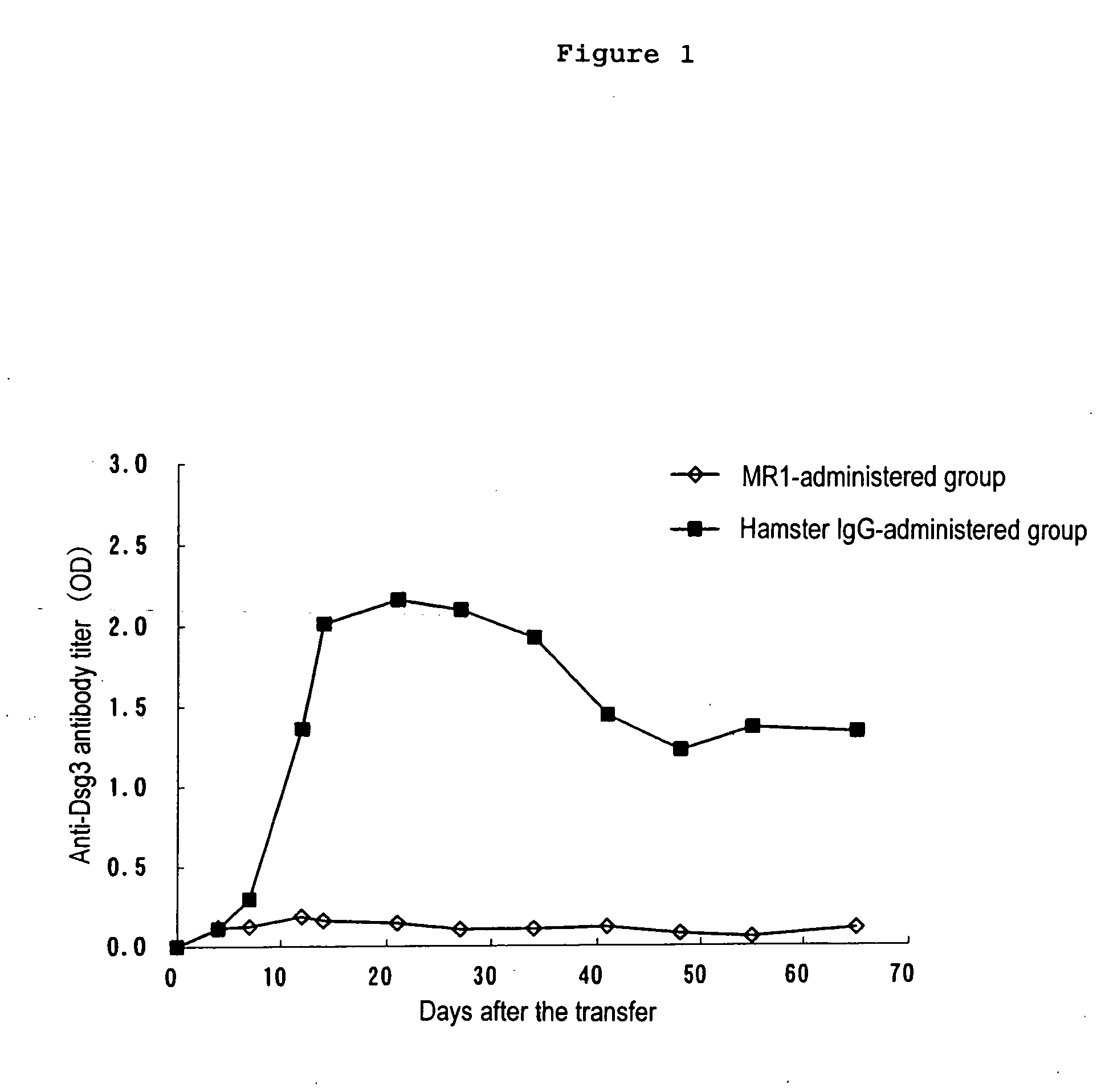Remedies for pemphigus containing cd40l antogonist as the active ingredient
a technology of pemphigus and active ingredients, applied in the field of re, can solve the problems of difficulty in continuously producing an antibody against dsg3 by immunizing wild-type mice, and achieve the effects of suppressing the production of anti-dsg3 antibody, skin and mucosal lesions, and improving the phenotype of some mi
- Summary
- Abstract
- Description
- Claims
- Application Information
AI Technical Summary
Benefits of technology
Problems solved by technology
Method used
Image
Examples
example 1
Generation of Model Mice with Pathologic Conditions of Pemphigus
[0034] Model mice with pathologic conditions of pemphigus were generated according to the method of Amagai et al (Amagai M., et al., J. Clin. Invest., 105, 625-631, 2000).
[0035] The rDsg3-immunized Dsg3− / − mice were killed under ether anesthesia and the spleens were extracted. The splenocytes were prepared under sterile condition and then suspended in PBS at 1×108 / ml, and subsequently 0.5 ml of the suspension (5×107 cells) was intravenously injected to Rag2− / − mice via the tail veins.
[0036] Production of IgG antibodies against Dsg3 was observed in the blood of recipient mice 4 to 7 days after the transfer and this antibody production was sustained for as long as 6 months or longer. The Dsg3 antibody deposition was confirmed on the cell surface of stratified squamous epithelia such as skin, oral mucosa and esophagus of the mice, in addition to which, the suprabasilar acantholysis, characteristic feature of pemphigus v...
example 2
The Preventive Effect on Pemphigus by the Administration of MR1 Antibody
[0037] It was examined whether the transferred splenocytes were capable of inducing immunological tolerance to Dsg3 when MR1 antibody was preventively administered so that CD40L was present at the time of inducing immune response to Dsg3.
[0038] 500 μg each of MR1 antibody and the control hamster IgG was intraperitoneally administered to recipient mice (Rag2− / − mice) (n=5) 2 days before the transfer of Dsg3− / − mouse splenocytes and 0, 2, 4 and 7 days after the transfer.
[0039] Production of the anti-Dsg3 antibody was confirmed in the control group 14 days after the transfer, while any apparent antibody production or phenotype was not observed at all throughout the observation period of 66 days in the MR1-administered mice (FIG. 1). In addition, weight loss, hair loss in resting period and the immediate suprabasal acantholysis which is a pathohistological feature of PV was observed in the control group, whereas ...
example 3
Therapeutic Effect on Pemphigus by the Administration of MR1 Antibody
[0040] MR-1 antibody was administered to the mice that had been introduced with the Dsg3− / − mouse splenocytes and that had exhibited development of PV as shown by their production of antibodies against Dsg3, and the presence or absence of any therapeutic effect was examined.
[0041] Recipient mice (Rag2− / − mice) introduced with the non-immunized Dsg3− / − mouse splenocytes were administered 1 mg each of MR1 and hamster IgG twice a week for 6 weeks, for the total of 12 times, starting from 7 weeks after the transfer of splenocytes (n=10). Untreated PV model mice were monitored at the same time to see a usual change in antibody titers (n=5).
[0042] Blood was collected 0, 2, 4 and 6 weeks after the initiation of administration and antibody titers to Dsg3 was measured. Statistical analysis was carried out except for mice that showed high antibody titers (mice showing 2000 or higher fold-increase in antibody titers) befor...
PUM
| Property | Measurement | Unit |
|---|---|---|
| fluorescent | aaaaa | aaaaa |
| water-soluble | aaaaa | aaaaa |
| stable | aaaaa | aaaaa |
Abstract
Description
Claims
Application Information
 Login to View More
Login to View More - R&D
- Intellectual Property
- Life Sciences
- Materials
- Tech Scout
- Unparalleled Data Quality
- Higher Quality Content
- 60% Fewer Hallucinations
Browse by: Latest US Patents, China's latest patents, Technical Efficacy Thesaurus, Application Domain, Technology Topic, Popular Technical Reports.
© 2025 PatSnap. All rights reserved.Legal|Privacy policy|Modern Slavery Act Transparency Statement|Sitemap|About US| Contact US: help@patsnap.com


